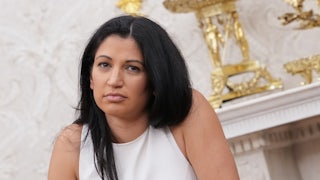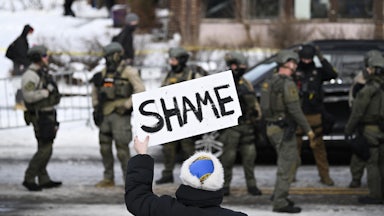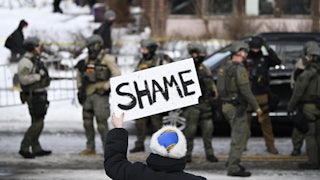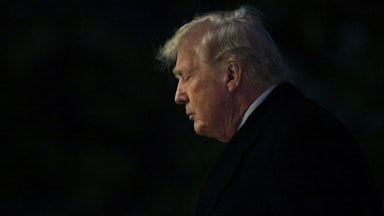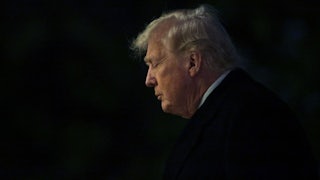With college students returning to campus, and the brutal war in Gaza continuing unabated, many schools—including mine—are bracing for renewed protests. As president of Wesleyan University in Connecticut, I have already received demands from pro-Palestinian undergraduates—not to mention emails from students, parents, and alumni demanding that I silence those undergraduates. Throw in the heightened tension of a presidential election in two months, and the coals on many campuses may only get hotter.
That’s a good thing. Colleges and universities should not retreat into some fantasy of neutrality. They should help students practice something that has become a prominent theme in the presidential race: freedom.
In the West, the student has long been conceptualized as someone on the path to freedom, to thinking for oneself in the company of others. It’s an idealized notion, to be sure, but a practical one as well. The proof of a good education is that one’s capacity to learn continues to grow after graduation—and that’s precisely what economies that prize innovation, and democracies that encourage deliberation and change, need from their participants. The student, practicing freedom on a path to maturity, learns how to attend to others; and paying attention is a key step in creating opportunities, righting wrongs, or helping those who are suffering. The good student turns out to be a good thinker, a good provider, and a good neighbor.
The good student doesn’t do this alone. Deeply embedded in the culture of American higher education is the notion of what literary historian Andrew Delbanco calls “lateral learning, the proposition that students have something important to learn from one another.” While we expect professors to offer instruction in the fields in which they have expertise, most American colleges, especially residential ones, promise that learning will be a communal journey in which one’s peers help one to flourish. But if these peers are too much like oneself, if a student too easily “fits in” at a college, then the journey won’t go far.
Homogeneity in the student body—not only in terms of racial or ethnic identity, but also in points of view, belief systems, aspirations, interests, and so on—undermines colleges’ mission to help students develop personal autonomy. That’s why it’s so important for schools to recruit students from every part of the country (and, if possible, from around the world). It’s also why the Supreme Court decision ending race-based affirmative action was so pernicious: It privileges (questionable) notions of individual fairness over community diversity, causing the community as a whole to learn less. Lateral learning really only works when students, both inside and outside the classroom, have to navigate difference—it’s a critical element to practicing freedom.
At the same time, if we truly believe in the benefits of diversity, we in higher education should take to heart criticism of our own insularity and our role in effectively reinforcing forms of inequality and elitism. If our students are learning to look down on anyone who lacks the same level of education, then our talk about diversity can seem just a cover for defending the current economic and cultural hierarchy. Wearing the mantle of progressivism doesn’t get you off the hook. Just because you believe you are on the right side of history doesn’t justify contempt for those who don’t share your vision of the future.
In education, insularity should be the enemy. Yet we liberal-arts academics, despite celebrating broad learning, often nurture niche cultures and speak in esoteric dialects that would seem foreign to many Americans. At the same time, extreme parochialism has been growing in the public sphere, thanks in part to fear-based politics. This is antithetical to liberal learning, whether it is conducted under the reactionary guise of various nationalist causes or the progressive guise of defending the latest version of a “minoritized” identity. In both cases, certain kinds of people are too often dismissed as having nothing to teach us.
Writing off people with whom one disagrees will always be easier than listening carefully to their arguments or attending to their creative endeavors. But without tolerance and open-mindedness, inquiry can be at best just a path to self-congratulation, and at worst, violent scapegoating. By contrast, a liberal education should deepen one’s ability to learn from people unlike oneself and with whom one doesn’t agree. Such a relation to others can help calm the politics of resentment raging about us.
But does it? Critics of higher education say it’s a phony meritocracy, accuse faculty of indoctrinating students, and claim that students pad their résumés with meaningless credentials and demand straight A’s merely for having completed the assignments. The charges of unfair student admissions that underpinned the legal assault on affirmative action, like the criticisms above, attack the integrity of learning as a path to freely thinking for oneself. After all, if the opportunity to study is unevenly made available to people, then it should be rejected by a thoughtful person who recognizes that such education is really corruption. If going to college means participating in one’s own indoctrination, then one can find no enlightenment there.
Campuses have long been screens upon which the broader culture expresses its anxieties about political and social change, economic dislocation, and the decline of traditional mores. Critics on both the left and the right haven’t been questioning the modern Enlightenment idea of learning as a journey to maturity so much as doubting whether students were actually on that path. Whether accusing students of radicalism or conformism, apathy or grade-grubbing, nearly all critics bemoan the inability of undergraduates to think for themselves.
Critics of higher education want it to live up to the ideal of being an opportunity for learning freedom. So do its defenders. And so do many of its students. To that end, there are two fundamental pragmatic goals for the university: to preserve culture and to stimulate inquiry for the sake of social progress. Of course, we will debate with one another about how much we should be preserving and what really counts as progress. But those debates help higher education fulfill its purposes—by offering an opportunity, to paraphrase John Dewey, to teach students to share in the arts of living. “Civilization is uncivil,” he wrote, “because human beings are divided into non-communicating sects, races, nations, classes and cliques.” We practice freedom to break down those artificial divisions and to open up possibilities of meaning, of joy, and of productive work.
Practicing freedom can be messy, as it surely will be on many campuses this fall. Thinking for yourself in the company of others, especially when the coals are hot, is not easy. But our disagreements will teach us lessons that will serve us well long after the coals have cooled.


